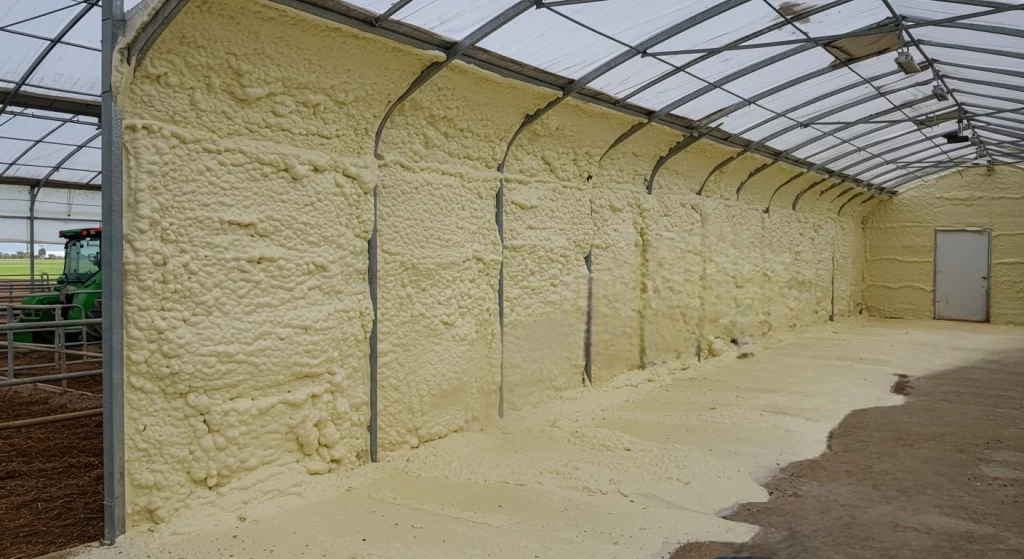Spray foam insulation shields agricultural structures from temperature fluctuations, moisture, pests, and energy waste. It adheres to surfaces, creating a seamless, airtight barrier that outperforms traditional insulation in metal, wood, or concrete-framed barns, storage units, or animal enclosures. In climates like Nevada’s hot, dry summers and cold desert nights spray foam maintains interior temperature stability and reduces condensation.
This guide presents specific data and technical comparisons to help determine how and where spray foam adds the most value in agricultural settings. Nevada Urethane applies insights from on-site experience across different building types and insulation challenges.
Spray foam is applied as a liquid that expands to fill gaps. This process results in full coverage without joints, which prevents thermal bridging and moisture infiltration, two of the most common causes of agricultural building degradation.
| Feature | Spray Foam | Fiberglass Batts | Rigid Foam Boards | Cellulose Blow-in |
|---|---|---|---|---|
| Air Seal | Excellent | Poor | Moderate | Moderate |
| Moisture Resistance | High | Low | High | Low |
| Pest Resistance | High | Low | Moderate | Low |
| R-Value per Inch (avg) | 6.0 (closed-cell) | 3.2 | 5.0 | 3.5 |
| Durability (Years) | 25+ | 10-15 | 20 | 10-15 |
| Application on Uneven Surfaces | Yes | No | No | Yes |
Bonus Tip: For barns storing feed, use closed-cell foam to create a vapor barrier that prevents spoilage from humidity.
| Property | Closed-Cell Spray Foam | Open-Cell Spray Foam |
|---|---|---|
| Density (lbs/ft³) | 2.0 | 0.5 |
| Water Absorption | <1% | >5% |
| Perm Rating | <1 | >10 |
| Sound Dampening | Moderate | High |
| Expansion Rate | 30:1 | 100:1 |
| Recommended Thickness (NV) | 2″ – 3″ | 3″ – 5″ |
Bonus Tip: In dusty agricultural environments, use a thermal barrier coating over spray foam to protect against UV and abrasion.

Spray foam reduces HVAC use by improving thermal consistency. According to the U.S. Department of Energy, buildings using spray foam cut energy bills by 10-30% annually (Source: energy.gov). In agricultural settings, this can translate to thousands saved in temperature-controlled livestock housing or produce storage.
A 2023 report from IBHS shows that spray foam insulation improves structural wind resistance in metal buildings by up to 200% by adding rigidity to wall and roof assemblies.
Nevada Urethane provides targeted services based on real-world agricultural needs:
Yes, after surface prep to remove dust, rust, and oils.
Once cured, yes. Ensure proper ventilation during application.
Most barns or silos can be insulated in 1-2 days, depending on size.
Yes, if foam remains exposed inside the building per code.
For more information or to discuss your project:
Nevada Urethane Email: [email protected] Phone: (775) 500-0024
Inspect for physical damage or UV exposure annually. Re-coat if foam becomes brittle or discolored.
Closed-cell spray foam resists dust penetration. Use a topcoat to maintain performance.
Yes. It reduces condensation, strengthens the structure, and adheres directly without fasteners.
Unlikely. The dense structure of closed-cell foam discourages nesting and burrowing.
Yes. It maintains internal conditions during hot days and cold nights, minimizing thermal shock.
